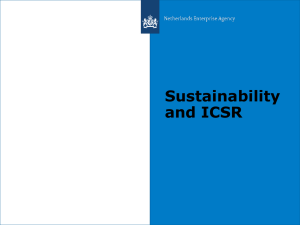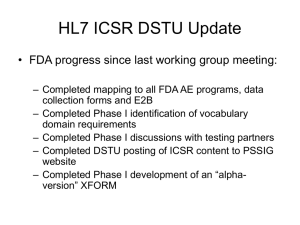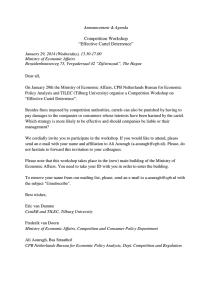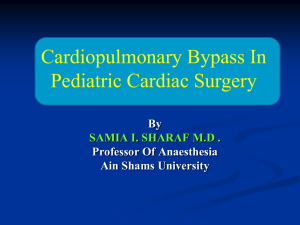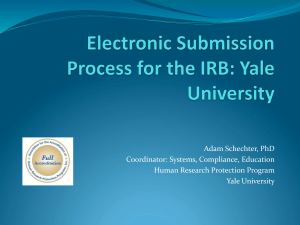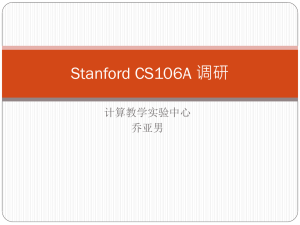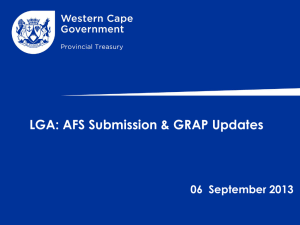Safety Reporting Requirements in Asia: A Pharmacovigilance Overview
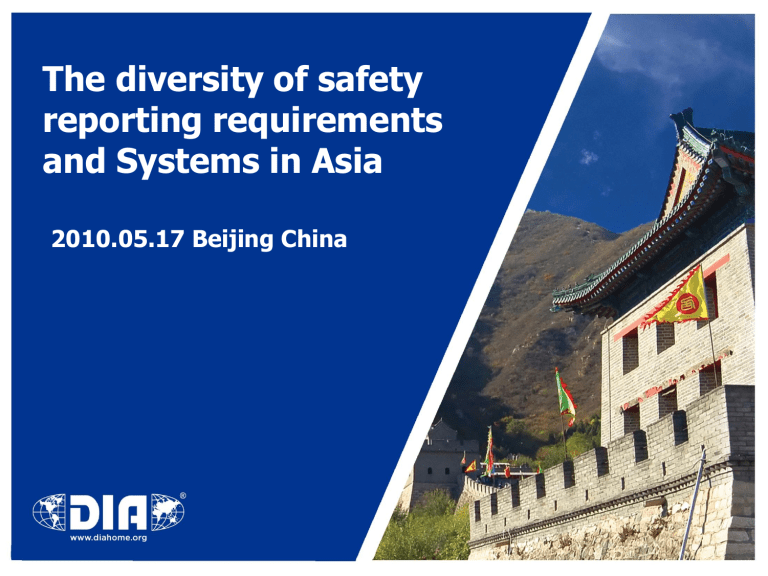
The diversity of safety reporting requirements and Systems in Asia
2010.05.17 Beijing China
1
Presenter
Jean-Christophe DELUMEAU MD PhD
Head of Pharmacovigilance Asia-Pacific
Bayer Healthcare
Global R&D Center Asia, Beijing
+86 10 6536 0829 office phone
+86 13910420935 Blackberry phone http://www.linkedin.com/in/delumeau delumeau.phv@me.com
Disclaimer; The views and opinions expressed in the following slides are those of the individual presenter and should not be attributed to DIA or Bayer Healthcare.
2
Harmonization in Pharmacovigilance
ICSR submission requirements
Electronic submission (E2B standards)
Aggregate reports submission requirements
Coding dictionary
Risk Management Plan and Risk mitigation requirements
3
Harmonization in Pharmacovigilance
ICH countries and beyond
ICH Guidelines and MEDDRA dictionary implemented in USA, EU and Japan and more or less followed by other countries
Specific Risk Management requirements
Europe
USA
Specific ICSR submission requirements e.g.
France-specific causality assessment (imputabilite)
Spain: Mandatory reporting in Spanish
E2B submission of ICSRs from Global pharma databases
USA and Canada
All 27 countries of the European Union + Norway, Iceland and Croatia
4
E2B systems for ICSR management
5
WHO-UMC
International Safety Survey
Uppsala Monitoring Center appointed by WHO
Preferred ICSR transmission standard: E2B
Alternative: old INTIS standard
6
High degree of diversity in Asia
Diversity of ICSR submission requirements
Diversity of aggregate reports submission requirements
Only a few countries are requesting RMPs
Most countries are still using WHO-ART
Only Japan is has an E2B safety data base, but E2B-J
Most AP countries are still using INTIS to forward ICSRs to the UMC
Electronic submission is not possible
An increasing number of countries request entering ICSRs into a country-specific web-based system
7
Diversity of Safety Systems In Asia
Japan-specific E2B submission mandatory
E2B-Vigiflow implemented in November 2010
Non E2B system – web submission mandatory
Non E2B system – web submission requested
Non E2B system – web system available
No E2B submission – no web system
Japan
India
China
Korea
Thailand
Taiwan
Malaysia
Singapore
Vietnam
Indonesia
Philippines
Hong Kong
Cambodia
Pakistan
8
Language for domestic ICSR Submission
Indonesia
Vietnam
Cambodia
Thailand
Taiwan
China
Korea
Japan
ENGLISH and/or
LOCAL
LANGUAGE
ACCEPTABLE
Hong Kong
Singapore
Malaysia
India
Pakistan
Philippines
LOCAL
LANGUAGE
MADATORY
ENGLISH
MANDATORY
9
ICSR submission requirements in Asia
ICSR submission requirements vary considerably across countries depending upon
Language requested for submission
Domestic or foreign case
Solicited or non-solicited
Seriousness
Causality
Submission time frame
Definition of the clock start
Age of the product on the market
Reference used for listedness
10
Safety submission requirements
East Asia
Japan
Korea
China
Hong Kong
Macao
Taiwan
Domestic
Solicited
Domestic
Non Solic.
Overseas
Solicited
Overseas
Non Solic.
Lingua
語
Web
Submiss.
E2B eSub
Aggregate
Reports
RMP
日本語 No Yes 日本語 日本語
한국어 Mandatory No 한국어 not yet
中文 Mandatory No 中文 中文
Eng.
中文 No
No
No
No
G-PSUR G-RMP
Eng.
中文 Possible No G-PSUR discussions
Expedited: Global ICSR format acceptable Unavailable or no requirement
Expedited: Country-specific ICSR format specified
G-PSUR G-RMP
Specific Specific
11
ICSR Reporting requirements
Hong Kong
12
ICSR Reporting requirements
Korea
13
ICSR Reporting requirements
Taiwan
14
ICSR Reporting requirements
China
15
ICSR Reporting requirements
Japan
16
Safety submission requirements
ASEAN
Domestic
Solicited
Singapore
Brunei
Malaysia
Thailand
Indonesia
Philippines
Vietnam
Cambodia
Laos
Myanmar
Web
Domestic
Non Solic.
Web
Overseas
Solicited
Overseas
Non Solic.
G-PSUR G-PSUR
G-PSUR G-PSUR
Expedited: Global ICSR format acceptable
Expedited: Country-specific ICSR format
English Web
Submis.
Standard Possible
Standard
Standard Possible
Accepted Expected
Accepted
Standard
Accepted
E2B eSub
Aggregate
Reports
RMP
No G-PSUR G-RMP
No
No G-PSUR
No G-PSUR
No G-PSUR
No G-PSUR
No G-PSUR
Unavailable or no requirement specified
G-PSUR
Specific
G-RMP
Specific
17
ICSR Reporting requirements
Indonesia
18
ICSR Reporting requirements
Thailand
19
ICSR reporting requirements
Philippines
20
ICSR reporting requirements
Vietnam
21
ICSR Reporting requirements
Singapore
22
ICSR Reporting requirements
Malaysia
23
Safety submission requirements
South Asia
India
Pakistan
Sri Lanka
Maldives
Bangladesh
Nepal
Domestic
Solicited
Domestic
Non Solic.
Overseas
Solicited
Overseas
Non Solic.
Expedited: Global ICSR format acceptable
Expedited: Country-specific ICSR format
Lingua
語
Web
Submiss.
E2B eSub
Aggregate
Reports
English Hospitals No G-PSUR
English No No G-PSUR
Unavailable or no requirement specified
RMP
G-PSUR G-RMP
Specific Specific
24
ICSR Submission requirements
Pakistan
25
ICSR Submission requirements
India
2011.05.11: the Central Drugs Standard Control Organization (CDSCO) circulated a new guidance for the reporting of Serious AEs from clinical trials.
Obligation to report within 14 calendar days
Causality to be assessed yes/no
Obligation to report compensation status in case of death
India-specific report form
26
ICSR Submission requirements
India
New reporting form proposed by the CDSCO
27
ICSR Submission requirements
India
Categories of clinical trials to be specified in the new reporting form
28
Impact of country-specific requirements
ICSR submission from global safety system is possible
e-submission: not available in any AP country so far
Printed on PDF or paper from the global company safety database
ICSR submission via country-specific E2B system is possible
Submission to the PMDA in Japan ( 日本語 )
ICSR submission via National web system is mandatory
China ( 中文 )
Korea ( 한국어 )
Thailand ( English acceptable )
Concern: more and more counties will make it mandatory
29
Impact of country-specific requirements
Japan
ICSR submitted electronically to the PMDA (E2B-J standard)
Japan-specific requirements e.g. Japanese language, specific reporting form, specific causality assessment rules
Most companies use a J-specific system e.g. Perceive, Clinical Works in addition to their Global PV system thus duplicating data entry work
Solutions to mitigate the impact
Data transfer bridging applications to minimize duplicating data entry.
Global system perspectives
Alice (HP): only global system operating submission to PMDA
Aris/Aris-J may be connected
Argus/Argus-J (Oracle) not connectable so far but connecting the two platforms may be considered
30
Impact of country-specific requirements
Korea
All domestic ICSRs must be entered in Korean language
Into the web system Easydrug (except GCP trial cases)
e-submission not yet possible
KFDA is able to forward ICSRs to WHO’s UMC on E2B format
No Korean version of Meddra to map Korean vs English medical terms
Solutions to mitigate the impact
Parallel data entry into global system and Easydrug
Developing E2B transmission and Meddra capability
Need for collaboration between the KFDA, Software providers and
Industry
31
Impact of country-specific requirements
China
Domestic ICSRs to be entered in Chinese into ADR center web system
e-submission of ICSRs impossible (Not E2B compatible)
WHO-ART still used although a Chinese version of MEDDRA exists
Causality and Seriousness categories are specific to China
Need to submit China-specific aggregate reports
Not fully consistent with documents submitted to EMA and FDA
Implications
Duplication of data entry work for multinational companies and Chinese hospitals participating into international safety research
To forward ICSRs to the UMC, the Chinese ADR Center needs to use the old INTIS or convert cases into E2B format
32
Impact of country-specific requirements
China
Revised Drug Affair Law at final stage of approval at Ministry of
Health anticipated to be released in 2011 but still awaited
New National ADR center database with web-based facility expected to become available by June 2011
The need to make the replacement Chinese safety database compatible with the E2B world seems now recognized by the SFDA and ADR who are looking for bridging solutions
33
Advantages for moving toward E2B
Advantage for Health Authorities
Recommended by the WHO-UMC for data transfer
Facilitate ontribution to international safety research
Enable using advanced signal detection systems e.g Empirica or VigiMine
Larger sample size for signal detection in specific ethnic groups
Advantage for the pharmaceutical industry
Avoid duplication of data entry workload
Focus resources on signal detection and benefit/risk optimization
34
E2B systems for ICSR management
Used by the Pharma Industry e.g.
AERS (Oracle)
ARGUS and ARGUS-J (Oracle)
ARISg and ARISj (Aris Global)
Safety-Easy (ABcube)
Company-specific (e.g. MSD, AZ etc..)
For Health Authorities e.g.
AERS (Oracle) used by the FDA
Eudravigilance (EMA-specific)
Vigiflow (UMC) used by SwissMedic
ARISg used by the French Medicinal Agency
Safety-Easy (ABcube)
35
E2B solutions
for National Heath Authorities
ORACLE AERS
Oracle actively promoting AERS for regulatory authorities
For signal detection, following the acquisition of Phase Forward,
Oracle is working on integrating Empirica Signal (developed in collaboration with the FDA) into the AERS platform
In a second step, Empirica Signal will be integrated into the Argus platform as Argus Perceptive will be discontinued.
36
E2B solutions
for National Heath Authorities
VIGIFLOW (WHO-UMC) may be set in 3 different ways
ICSRs entered locally and forwarded to the central UMC database
ICSRs entered locally and forwarded to a Country-specific database container maintained by the UMC in Uppsala
Setting a Vigiflow system in the Country (full license needed)
Vigiflow is designed to be customised to local languages
The UMC is keen to support interfacing Vigiflow with E2B-compatible ICSR submission systems of the Pharmaceutical industry
Cost-effective way to open the door to ICSR e-submission in countries with limited budget to purchase and maintain a national safety database
37
Diversity of Safety Systems In Asia
News as of 2011.05.17
India: Vigiflow implemented in November 2010 at the All India Institute of
Medical Sciences (AIIMS) to support the Pharmacovigilance Program of India
(PvPI). In April, the Ministry of Health appointed the Indian Pharmacopoeia
Commission (IPC). IPC will also be using Vigiflow. New requirements for reporting
SAEs from clinical trials
China: The National ADR Center is planning to implement a new ADR-reporting web-based system in June 2011. The date of release is not confirmed. This system is not anticipated to be E2B compatible, however the ADR center has decided to look for solutions to bridge their new system with the E2B world
Taiwan: In January 2011, Taiwanese ADR center sent a questionnaire to the
Pharma industry inquiring on the benefit for moving to an E2B system
Vietnam: The DI&ADR center is planning to set a locally designed countryspecific web-based ICSR reporting system
Singapore, Malaysia, Thailand, Australia, New Zealand are considering acquiring an E2B system but there seem to be no clear decision so far
38
Different viewpoints but sharing similar goals
National Health Authorities
Domestic pharmaceutical companies
International Organisation
Multi-National pharmaceutical Companies
All Pharmacovigilance professionals
Aiming at ensuring the safe use of medicinal agents
Facing Increasing amounts of ICSRs
Dealing with limited resources
Harmonization helps avoiding duplicating work and focusing on Benefit versus Risk Management
Harmonisation for better health (ICH Mission Statement)
39
Thank you for your attention
40
